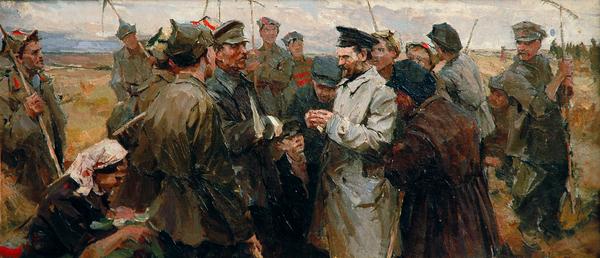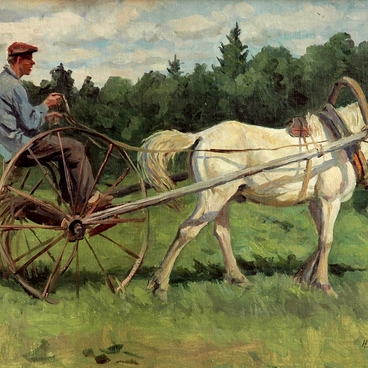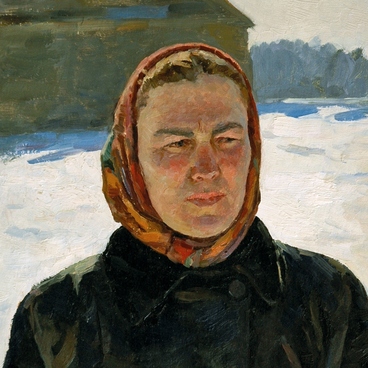In this painting, the artist Ivan Ivanovich Mikheev, a native of the village of Krasnoye Kolychevo, Lev Tolstov District, Lipetsk Region, depicts a key political figure of the Soviet era, Mikhail Ivanovich Kalinin (1875–1946).
Kalinin was a Russian revolutionary, political activist, party worker, and Hero of Socialist Labour. For 27 years Kalinin served as chairman of the Central Executive Committee of the USSR and then the Presidium of the Supreme Soviet of the USSR and actively participated in the preparation and carrying out of the October Revolution. Born into a peasant family (Kalinin was born in the Tver Governate), Mikhail Ivanovich was distinguished by his rapport with ordinary people, workers, and peasants - the primary population of the country. In 1919, Trotsky nicknamed him the ‘Village Chief of all Russia’ for this rapport, and after 1935 the name ‘Village Chief of all USSR’ was adopted by the people.
The event depicted in the picture took place on 17 July 1919. Propaganda campaigns were getting underway at that time during the Civil War. Kalinin visited Atkar County, Saratov Governate on the October Revolution propaganda train. Atkar County existed from 1780 to 1928. In 1928 it was abolished, with Atkar Okrug, Saratov District, Lower Volga Region taking in its place.
Approximately four thousand people came to hear Kalinin. In addition to the townspeople, there were also many soldiers and peasants. The harvest that year was particularly bountiful and stood at centre of the delegation’s attention. Emergency commissions were organized in Atkarsk in the shortest time possible and succeeded in mobilizing almost the entire able-bodied population of the county to take part in the harvest. Kalinin’s speech in Atkar County was especially important because at that moment Denikin’s troops were advancing on Tsaritsyn and Kamyshin, and the front-line grain district required special attention on the part of the Soviet government.
In the picture, Mikheev has portrayed Kalinin surrounded by soldiers of the Workers’ and Peasants’ Red Army and ordinary residents of Atkarsk. He is right there in the thick of things, together with the people and does not shirk close interaction with the peasants. Kalinin’s speeches would normally begin with his asking people to tell him frankly about their lives and needs. Thus, he was able to foster a rapport with them and inspire their special trust.
When Vladimir Lenin recommended Kalinin for the post of chairman of the All-Russian Central Executive Committee in 1919, he said: ‘This is a comrade with approximately twenty years of party work; he himself is a peasant from the Tver Governate and is closely tied to the peasant economy… The Petrograd workers experienced for themselves his rapport with the broad range of working masses…’
Kalinin was a Russian revolutionary, political activist, party worker, and Hero of Socialist Labour. For 27 years Kalinin served as chairman of the Central Executive Committee of the USSR and then the Presidium of the Supreme Soviet of the USSR and actively participated in the preparation and carrying out of the October Revolution. Born into a peasant family (Kalinin was born in the Tver Governate), Mikhail Ivanovich was distinguished by his rapport with ordinary people, workers, and peasants - the primary population of the country. In 1919, Trotsky nicknamed him the ‘Village Chief of all Russia’ for this rapport, and after 1935 the name ‘Village Chief of all USSR’ was adopted by the people.
The event depicted in the picture took place on 17 July 1919. Propaganda campaigns were getting underway at that time during the Civil War. Kalinin visited Atkar County, Saratov Governate on the October Revolution propaganda train. Atkar County existed from 1780 to 1928. In 1928 it was abolished, with Atkar Okrug, Saratov District, Lower Volga Region taking in its place.
Approximately four thousand people came to hear Kalinin. In addition to the townspeople, there were also many soldiers and peasants. The harvest that year was particularly bountiful and stood at centre of the delegation’s attention. Emergency commissions were organized in Atkarsk in the shortest time possible and succeeded in mobilizing almost the entire able-bodied population of the county to take part in the harvest. Kalinin’s speech in Atkar County was especially important because at that moment Denikin’s troops were advancing on Tsaritsyn and Kamyshin, and the front-line grain district required special attention on the part of the Soviet government.
In the picture, Mikheev has portrayed Kalinin surrounded by soldiers of the Workers’ and Peasants’ Red Army and ordinary residents of Atkarsk. He is right there in the thick of things, together with the people and does not shirk close interaction with the peasants. Kalinin’s speeches would normally begin with his asking people to tell him frankly about their lives and needs. Thus, he was able to foster a rapport with them and inspire their special trust.
When Vladimir Lenin recommended Kalinin for the post of chairman of the All-Russian Central Executive Committee in 1919, he said: ‘This is a comrade with approximately twenty years of party work; he himself is a peasant from the Tver Governate and is closely tied to the peasant economy… The Petrograd workers experienced for themselves his rapport with the broad range of working masses…’



